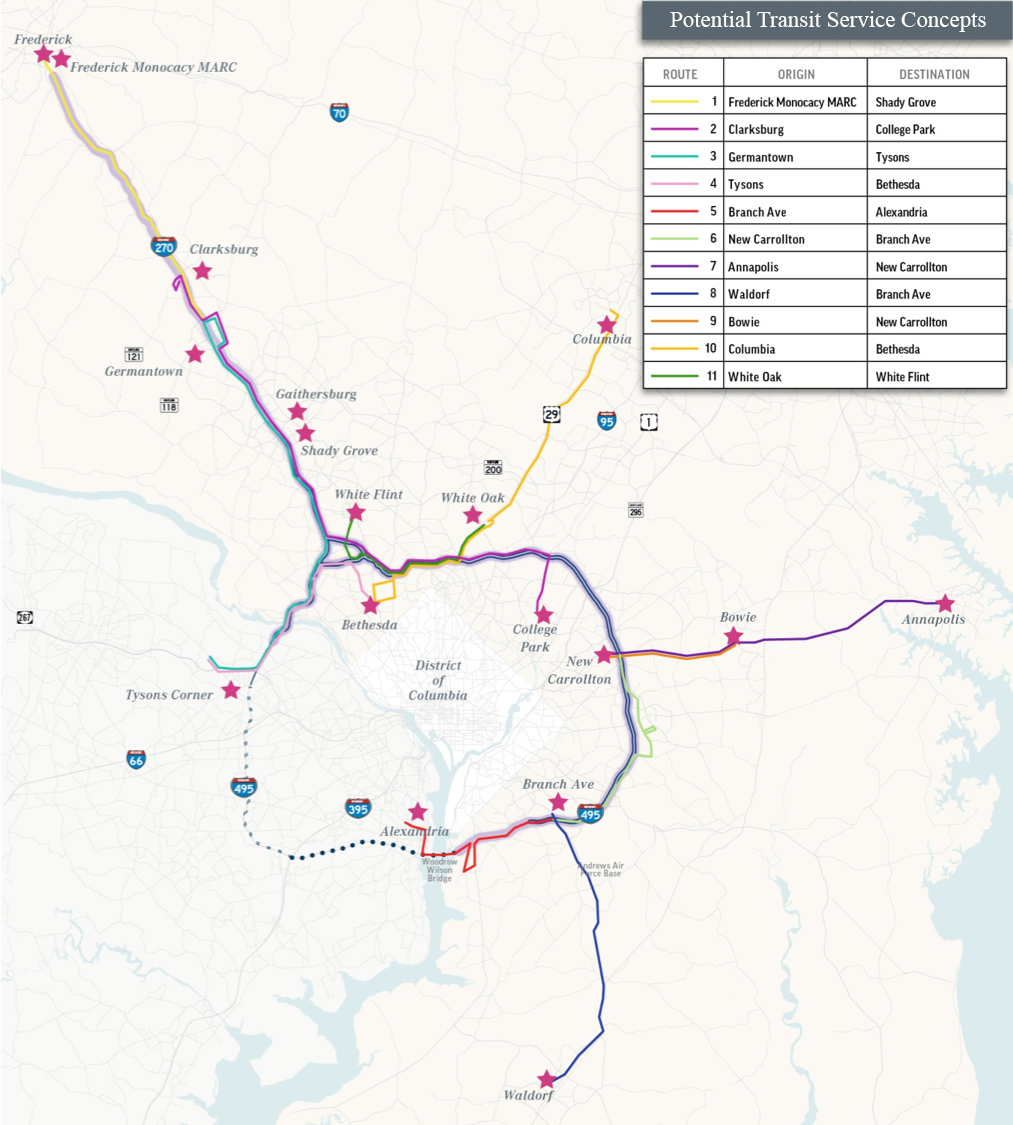Transit Benefits
While managed lanes provide new options for motorists, they also represent new opportunities for transit. The use of managed lanes to serve transit gives travelers more choices and offers greater transportation benefits. Managed lanes with a multimodal use can carry many more people than congested general purpose travel lanes, or standalone transit options.
In the National Capital Region, managed lanes have the potential to offer many short-term and long-term benefits to transit by:
- Enabling more efficient transit operations through a more reliable and faster system
- Providing opportunities for existing transit services to use the managed lanes
- Acting as new “fixed guideways” for transit
- Facilitating the opportunity for new market trials
- Offering the ability to more effectively provide transit services to underserved suburban to suburban markets
- Enhancing opportunities for partnership with Virginia to offer transit services
Transit Service Coordination Report
View the Transit Service Coordination Report
The Maryland Department of Transportation (MDOT) is committed to providing regional transit service improvements as part of the Public-Private Partnership (P3) agreements to be established under Op Lanes Maryland. In 2019 , MDOT convened a Transit Work Group (TWG) with local and regional transit providers and stakeholders to collaboratively identify opportunities to enhance transit services on the proposed managed lanes on I-495 and I-270 and create an interconnected transit/highway system in the National Capital Region.
The TWG included transit representatives from the counties directly affected by Op Lanes Maryland; including, Frederick County, Montgomery County, and Prince George’s County, as well as other partners from Anne Arundel County, Charles County, Howard County, Metropolitan Washington Council of Governments, Washington Area Metropolitan Transit Authority (WMATA), Federal Highway Administration (FHWA) and Federal Transit Administration (FTA) have participated in this effort in addition to MDOT, MDOT Maryland Transit Administration (MDOT MTA), and MDOT State Highway Administration (MDOT SHA).
How Transit Benefits From Managed Lanes

The TWG focused on the following activities:
- Review of existing and planned transit services
- Review of managed lanes access points
- Analysis of casual carpooling, van pooling and other ridesharing methods
- Evaluation of park and ride lot locations near the I-495 and I-270 corridors and their current capacity and usage
- Examination of potential markets for regional express bus service which would benefit from implementation of managed lanes
- Identifying potential new or modified routes
The result of the TWG is the Transit Service Coordination Report that outlines 11 potential transit services supported or indirectly benefited by the proposed managed lanes. The work of the TWG will inform the development of Op Lanes Maryland and will assist MDOT and the affected counties in identifying potential regional transit solutions to be developed collaboratively with the affected counties within the framework of Op Lanes Maryland.
Transit services are an integral component of the National Capital Region’s economic performance. MDOT is committed to providing regional transit service improvements to the affected counties as part of Op Lanes Maryland at defined and predictable times.
Terry Bellamy, Prince George’s County
The managed lanes project has the potential to significantly improve transit reliability. Prince George’s County is excited because it allows for the potential to develop virtual BRT services that could connect the Purple Line with activity centers in New Carrollton, Largo, Branch Avenue, National Harbor and even Alexandria, Virginia."
Bruce Gartner, Howard County
Howard County was pleased to be a member of the Transit Work Group. As a County within the Baltimore Metropolitan Planning Area with 38 percent of the commuter trips crossing our borders traveling between Howard County and the Washington Region, the County is appreciative of any efforts to enhance the limited transit service between the two regions. The Transit Work Group performed a comprehensive review, including regional travel patterns and population trends. They listened to us and developed a series of potential new public transit route concepts that could enhance and support ongoing transit investments. Howard County is highly interested in advancing opportunities to connect to Montgomery County's new Flash 29 BRT service and is supportive of efforts by Montgomery County and the State to improve reliable transit service between Columbia and Bethesda."
Ramond Robinson, Anne Arundel County
As regional travel has grown, Anne Arundel County has seen significant shifts that are on the periphery of the managed lanes project. As a member of the Transit Workgroup, we appreciate the inclusion and the ability to provide the Anne Arundel County perspective on the needs for regional travel. Many of our Anne Arundel County residents travel on arteries that feed in to I-495. A number of the local initiatives identified in Move Anne Arundel, the Anne Arundel County Functional Transportation Plan could benefit from similar efforts."
Ron Burns, Frederick County
We expect the managed lanes will provide faster and more dependable travel times between the City of Frederick and Bethesda. This will especially help speed up the MDOT MTA’s commuter buses and create even greater demand to our well used routes. Having expanded commuter bus and an all-day bus service connecting to Metrorail at Shady Grove will be important to relieving the congestion along I270 and will provide meaningful and much needed daily connections with the rest of the DC region for the citizens of the City of Frederick and the rest of Frederick County."
